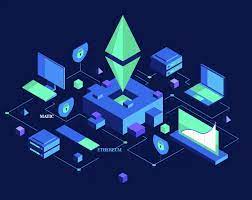
Polygon is a protocol and a framework for building and connecting Ethereum-compatible blockchain networks. Aggregating scalable solutions on Ethereum supporting a multi-chain Ethereum ecosystem. It was erstwhile known as Matic Network. Its live price as at the time of writing is $2.06 USD.

Feature Of Polygon (MATIC)
- It’s ETH compatible – Thus it has almost all the features of Ethereum. Industry dominance, established tech stack, tools, languages, standards, enterprise adoption.
- It’s Scalable – MATIC has a scalable consensus algorithms, custom Wasm execution environments and dedicated blockchains.
- MATIC is secured – It’s security is provided by Ethereum or by a pool of professional validators.
- Sovereignty – Dedicated throughput/resources, fully customizable tech stack, sovereign governance.
- Modularity – MATIC is highly customizable, It can be extensively upgraded and it has a short time-to-market, community collaboration.
- Comparable to Web2, “zero-gas” transactions and instant (deterministic) transaction finality – User Experience.
- MATIC is Interoperable – Native support for arbitrary message passing (tokens, contract calls etc), bridges to external systems.
- Developer Experience – Just as Ethereum Polygon (MATIC) requires no protocol level knowledge, no token deposits as well as fees or permissions.
Table of Contents
How Polygon (MATIC) Works

MATIC targets to transform Ethereum into a complete, multichain system, or internet of blockchains, with the added advantages of Ethereum’s robust protocol and security. MATIC works just like every other Proof-of-stake-based blockchain. Its validator nodes, client nodes token, local dapps, structure, etc., are similar to other networks except the factor that exchanges are clustered and settled over the Ethereum mainchain.

Luckily, it has parented a layer-2 network for building practical, Ethereum-viable blockchain networks.
A Layer-2 scaling solutions hint at off-chain solutions. This includes lessening or eliminating components with evaluation power from the prime blockchain prior to their execution somewhere else, for instance, on sidechains.
This builds throughput on the mainchain and spreads the evaluating proficiency across the network. Layer-2 solutions are receiving expanded fame as they play an essential role in the mass reception of cryptographic money.
The modular system of MATIC for assembling custom networks permits developers to send preset blockchain networks with just one snap. Besides, Polygon makes it simple for any blockchain to cooperate with another blockchain without any issues.

You can think about the MATIC sidechain as a valuable section of the vast universe of Ethereum, which offers clients prevalent project implementation and good working experience.
Each Ethereum-based decentralized app or some other Ethereum-viable blockchain can be converted to the Matic Sidechain to work in a considerably more improved climate.
Clients who want to interface with decentralized apps that have moved to the MATIC Sidechain are required to:
Verify the supposed Predicate Contract conveyed on the Ethereum network, bolting the tokens to be sent on the MATIC Sidechain.
After the predicate contract gets verified, tokens will be automatically stored on the MATIC Sidechain. In this cycle, a specific smart contract named “RootChainManager” activates another smart contract known as “ChildChainManager” that creates the proper measure of bolted or stored tokens on the MATIC network.
When clients accept their tokens on the MATIC Sidechain, they can move them quickly within the network with minor expenses. This implies that giving or exchanging liquidity utilizing a decentralized trade on MATIC will cost the client pennies rather than heavy dollars.
Steps to Pull out the tokens back to Ethereum:
The tokens must be scorched on the Matic sidechain. The verification of this scorched exchange must be delivered to the Ethereum mainchain. When this cycle is finished, the smart contract “RootChainManager” will store back resources for the client’s location (wallet) on the Ethereum mainchain.
The Security Of Polygon
MATIC secure its assets through a network of proof-of-stake validators and also through Layer 2 solutions, the integral part of the Polygon ecosystem is “staking”.
A number of validators on the network are allowed to stake their MATIC tokens as collateral in order to become part of the network’s PoS consensus mechanism and will receive MATIC tokens in return.

Other members of the network who do not wish to become validators are allowed to assign their MATIC tokens to a validator member, however, they will still take part in their staking process and earn staking rewards.

Additionally to the proof-of-stake check-pointing, Polygon uses block producers at the block producer layer to achieve a higher degree of decentralization. These block producers give finality to the main chains using checkpoints and fraud-proof mechanisms.
Who Owns Polygon (MATIC)

Polygon(MATIC) was founded in October 2017 by Anurag Arjun, Sandeep Nailwal and Jaynti Kanani. The three of them were the initial co-founders and they developed Polygon to solve the issues associated with Ethereum’s high gas fees and congested network, as described in the protocol’s original white paper.

Mihailo Bjelic, joined the company just after its rebranded to Polygon and became the companies fourth co-founder. Jaynt Kanani is the acting CEO.
The company also partners with Decentraland, Chainlink and MakerDAO. Mark Cuban is one of the companies biggest investors, he is a billionaire and the owner of the NBA team, the Dallas Mavericks.
Where Can I Stake Polygon (MATIC)
You can stake MATIC on popular exchanges such as;
MATIC is a token on the Ethereum blockchain. MATIC tokens are in stock for leverage on Ethereum (ERC20), Binance (BEP2) and Binance Smart Chain (BEP20).
In other to be able to delegate to a Polygon validator, you will need a minimum of 1 MATIC.

However, staking of MATIC does not happen on polygon mainnet rather it happens on the Ethereum blockchain.
Is Polygon (MATIC) A Good Investment

After reading the above piece about MATIC, you must be wondering if it’s worth an investment. MATIC is becoming progressively popular. However, there are few problems with the Ethereum network on which Polygon resides thus its scalability and transaction fees.
The company is trying to solve these problems by adding its protocols to the Ethereum chain. According to many investors, Polygon visage mainly improves the Ethereum network.
Their reason for saying this is it has connected it to other Ethereum-compatible blockchains and helped scale the Ethereum network.

With essence in the crypto market, MATIC is currently the 22nd most popular cryptocurrency by market capitalization, with a little over 11 billion dollars in the market cap. It is currently trading around $2.06 per token
Earlier this year, MATIC was trading less than $0.02 per token. Five months later thus May 2021, it went up to its highest of all-time $2.65 and over.
That is about a 15,000% return in just five months. However, the price has slowed down and is trading between $0.75 and $2.65 for a while now.
In my honest opinion, Polygon is worth investing in.
Will Polygon (MATIC) Go Up

Wondering if the price will go up, here is something for you. Several algorithm-based forecasting services share MATIC crypto price forecasts for the rest of the year and beyond (as of 30 November).
GovCapital believes MATIC can start 2022 at $1.99 rising to $3.82 by its end. It may hit $5.57 by the end of 2023 and hit $9.01 by December 2025.

Wallet Investor expects MATIC to be an “awesome” long-term investment. According to its Polygon crypto forecast, MATIC could start 2022 at $1.99 and rise to $3.72 by the end.
It suggests that by the end of 2023 it could reach $5.47 and $8.97 by the end of 2025.
DigitalCoin also holds a bullish view on the Polygon (MATIC) crypto price prediction, expecting a gradual increase to $3.14 by the end of 2021, reaching $3.77 in 2022, $4.58 in 2023, and $6.56 in 2025.
Although none of the services provides price targets for 2030, Digital Coin’s most distant price prediction is for $9.69 by the end of 2028.
When looking for MATIC price predictions, it’s important to bear in mind that analysts’ forecasts can be wrong. Analysts’ projections are based on making a fundamental and technical study of a crypto’s performance.
Past performance is no guarantee of future results.
Where to Buy Polygon or Matic
Polygon is listed on several exchanges, you can buy Polygon from the following well-established exchanges.
Summary
Polygon has great features and is providing real solutions to aid the development of decentralized applications, however, its main appeal has to do with solving issues that bedevil the ethereum mainnet.
One question remains in mind, what happens when Ethereum provides on-chain solutions that Polygon is using side chains to solve, will Polygon be as appealing as it is now? will developers prefer a side chain solution to on-chain solutions?
These are pertinent issues, one that is difficult to judge from here, often, it is hard to understand development timelines and goals from a third parties perspective.
One thing is certain, Ethereum and its developers are hard at work solving the challenges with the ethereum network, besides this, there are several decentralized platforms out there that set out completely to do exactly what ethereum does while fixing ethereums challenges from scratch.
Would these solutions be more appealing than side chains solutions? time will tell, but as of now, it seems developers are enjoying the awesome services that Polygon provide, so much so the price is on the rise!
We believe there is always going to be space for Polygon to operate, and long term Polygon is a good bet as Ethereums solutions are only beginning.
Development is hard, timelines are rarely met, one would prefer a working solution, to a future promise. For this reason, here at Orasio we generally agree that Polygon has a great future, and is a candidate for long term play, our 10 years forecast for Polygon places it at the $500 price point.
If you have some long term play money, Polygon might be a good choice.
We would email you of new and promising cryptocurrency projects, legit investments etc. once a week


